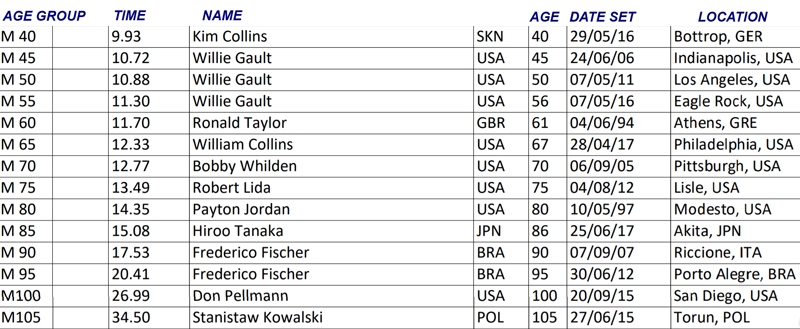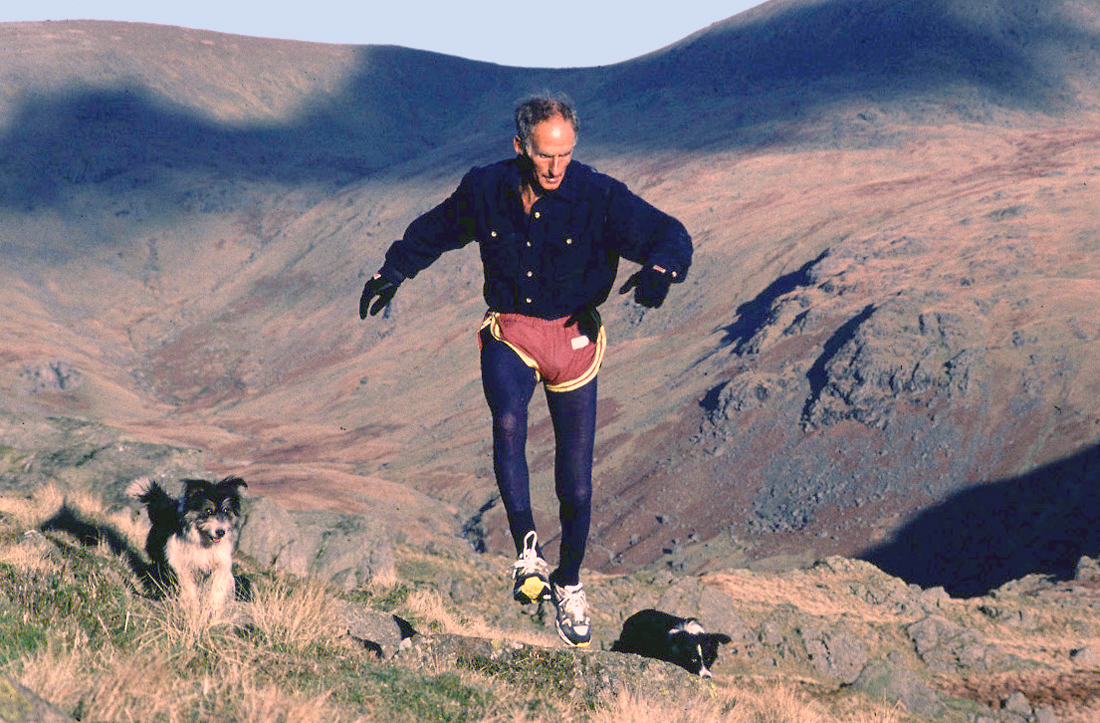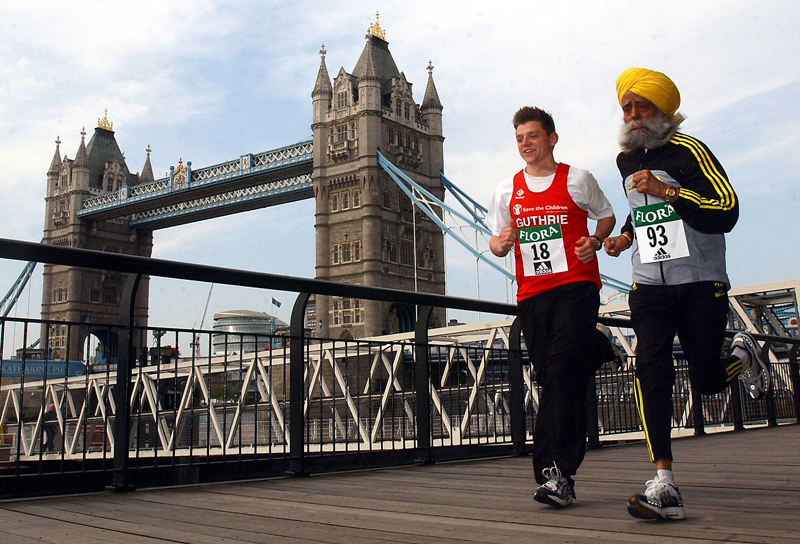Of all the physiological variables, speed seems to get written off most quickly as we age. Football pundits make jokes about outfield players being ‘a few yards slower’ and goalkeepers diving in ‘instalments’ as soon as the former hit 30 and the latter become David Seaman. But England’s Rugby World Cup winning pack averaged well over 30 and, despite being called ‘Dad’s Army’, still fathered a victory; the likes of Neil Back and Martin Johnson were certainly very speedy around the field. In track, Carl Lewis, Frankie Fredericks, Linford Christie and Merlene Ottey are – or were – still winning titles well into their thirties and, in the case of Ottey, beyond. But can veteran athletes still put in speedy sprinting performances in their forties, fifties, sixties – and beyond?
First, let’s take a look at why we slow with age. One significant factor is a decline in muscle mass and muscle fibre (sarcopenia). We will all experience a 10% decline in muscle mass between the ages of 25 and 50 and a further 45% shrinkage by our eighth decade – if we do nothing about it. To illustrate this decline by example, the biceps muscle of a newborn baby has around 500,000 fibres while that of an 80-year-old has a mere 300,000. As we age, we also produce less growth hormone, which leads to reduced levels of protein synthesis and, again, muscle atrophy. This is not the kind of acceleration needed by the veteran athlete in search of speed, as decreased muscle equates to reduced strength and power and less ‘oomph’ for sprinting.
Unfortunately, the bad news keeps on coming! Fast-twitch muscle fibre, that most precious of commodities for speed and power, displays a much more marked decline than slow-twitch fibre as we age. Speedsters, it appears, are not as blessed as endurance athletes in the ageing-and-performance stakes. The latter can expect to maintain their slow twitch fibres and even increase them – by as much as 20% with the right training – as they ripen. They can also hold on to nearly all their aerobic capacity until late into their fifth decade at least. If only it were so for their sprinting counterparts, whose fast-twitch fibre can decline by as much as 30% between the ages of 20 and 80.
To add another blow, creatine phosphate, that premium ingredient for short-term activity, also declines with age. With less quick-release energy in our muscles, we’re theoretically less able to tackle high intensity sprint-type workouts.
Flexibility, another important physiological variable for sprinting, also declines with age as our soft tissue hardens and our joints stiffen.
What are the known effects on performance of these various reductions in capacity? It gets worse! Numerous studies have indicated that stride length declines considerably with age. Korhonen analysed the performances of 70 finalists (males 40-88, females 35-87) in the 100m event at the European Veterans Athletics Championships in Jyväskylä, Finland in 2000, using high-speed cameras with a panning video technique to measure velocity, stride length, stride rate, ground contact time and flight time(1). Unsurprisingly, his research team discovered a general decline in sprint performance with age, which was particularly marked for those aged 65-70. Velocity during the different phases of the run declined, on average, between 5 and 6% per decade in men and 5-7% in women. Key to this decline was an accelerating reduction in stride length and an increase in contact time, with stride rate remaining largely unaffected until the oldest age groups in both genders.
Table 1: Master 100m world records by ascending age

Source: World Masters Athletics Association (as at March 2018)
Hamilton compared 35-39-year-old runners with 90-year-olds and found that stride length declined by as much as 40%, from 4.72 metres per stride (2.36m per step) to 2.84m per stride (just 1.42m per step). The implication is that the oldest veteran sprinters may need to take almost twice as many steps in the 100m as their younger counterparts. More positively, though, this research group also found that stride frequency did not decline significantly with age (2).
If you take a look at table 1, you’ll find some much better news. Take note of the phenomenal times recorded by master 100m sprinters; these indicate that it is possible to maintain a significant amount of speed with age. So now let’s take a look at what we have to do to achieve that goal.
Hill training for stride length
As we’ve seen, two crucial factors affecting speed decline in the older sprinter are a reduction in stride length and an increase in ground contact time. Hill sprinting can reverse these negatives; the gradient will emphasis dorsiflexion (a greater toe-up foot position) on foot strike, which will, in turn, generate more work for the calf muscles on push off, enhancing stride length and reducing contact time on the level. Lower limb and ankle strength and power are crucial for sprinters of all ages, although they can be overlooked by coaches and athletes in favour of conditioning the quadriceps and glutes.One of the key factors contributing to the age-related decline in stride length is the action of the free leg as it leaves the running surface and the foot travels a curvilinear path beneath the body to a forward position in preparation for the subsequent foot strike. An older runner’s ‘return phase’ is much less dynamic than that of his or her younger counterparts. For optimising speed transference into the next running stride, the lower leg needs to ‘fold up’ towards the butt and be pulled through quickly and powerfully as a short lever. This action relies on hip, glute and hamstring strength.
Returning to Hamilton’s work, she and her co-workers discovered that range of motion at the knees during running decreased by 33% – from 123° to just 95° – between ages 35 and 90. For the oldest runners in the study, this meant that the lower part of the leg attained a right angle with the thigh at the point of maximum flexion, dramatically slowing free leg transition into the next stride.
Hill sprints can play a key role in combating this lower leg lethargy; by creating a greater leg drive, they can increase the speed of the free leg through reaction to the ground and condition a much more effective and speedy biomechanical sprinting action.
Weights for fast-twitch maintenance
Weight training is crucial for mature sprinters determined to hang on to as much zip as possible, particularly after 50 when muscle mass begins to decline more steeply. Training with weights set around 75% of one rep maximum will offset fast- twitch fibre shrinkage quite significantly. Unfortunately, though, it has no impact on muscle fibre reduction, which is governed by an age-related decline in motor cells in the spinal cord.Weight training, by strengthening soft tissue, will also go some way towards protecting older speed merchants from injury.
Plyometrics for stretch/reflex
Plyometric exercises condition the stretch/reflex in our muscles and, as well as boosting speed and power, can stimulate the fast-twitch fibres of older sprinters into further action. As mentioned above, stride length declines significantly with age, and plyometrics, like hill training, offers another significant training option for offsetting this decline. Bounding and hopping are two very effective exercises for enhancing stride length.Intense exercise for GH release
Exercise is known to stimulate growth hormone (GH) release, which is crucial for speed maintenance in later life (3). Growth hormone helps us hold on to more lean muscle mass, retain more energy and offset some of the general effects of ageing. The positive release of GH begins almost immediately after we start to exercise, and it seem that the higher the intensity of the exercise, the more GH will be released.Stokes and co-workers compared the effects of maximal and less intense cycle ergometer sprinting in a group of 10 male cyclists, who completed 2 x 30s sprints separated by one hour’s passive recovery on two occasions (4). The first effort was completed against a resistance equal to 7.5% of body mass and the second to 10% of body mass. Blood samples were taken at rest, between the two sprints and one hour post exercise. Analysis of blood samples showed that the first effort elicited a much more significant serum GH response than the second. Note that, although both sprints generated the same peak and mean power outputs, the first allowed the cyclists to generate higher RPM scores – ie to pedal faster.
Despite the apparent attenuation of GH release in the second effort, since speed is maintained and enhanced by regular anaerobic training, silver sprinters should benefit from regular and above-normal GH release.
Creatine for muscle power
Intense speed and power training can also combat the normal age-related decline in creatine phosphate. Research has shown that anaerobic (and aerobic) training increases the production of creatine phosphate. Research by Moller and co-workers showed that six weeks of cycle ergometer training increased the creatine phosphate levels of 61-80 year olds to levels similar to those of younger adults (5). The regular anaerobic workouts of sprint training will maintain and increase the ability of our muscles to replenish high-energy phosphates, regardless of age.But since there’s nothing wrong with giving Mother Nature a legal helping hand, the older sprinter should take supplementary creatine. Numerous studies have shown that creatine supplementation can increase muscle power and power maintenance over a series of anaerobic repetitions and will contribute to the maintenance of lean muscle mass.
One interesting piece of research that specifically addressed sprinting threw up some encouraging – and other slightly less encouraging – information for veteran sprinters supplementing with creatine. Schedel et al looked at whether the improvement in maximal sprinting speed after creatine supplementation could be attributed to an increase in stride frequency, stride length, or both(6).
Seven sprinters completed four consecutive sprints after one week of placebo or creatine supplementation. By comparison with the placebo condition, creatine-fed sprinters increased their running speed (+1.4%) and stride frequency (+1.5%), but not their stride length.
This research also substantiated the use of creatine for sustaining power output, as decline in performance of subsequent sprints was partially prevented after supplementation with creatine. The researchers concluded that their findings could be related to the recent discovery that creatine supplementation can produce a shortening in muscular relaxation time, thus promoting increased sprint times.
Train smart for all-round benefits
Finally, the older sprinter needs to make use of the wiser head on his or her shoulders. Training needs to be intense to minimise the age-related decline in sprint speed, but it also needs to take account of the fact that older bodies may be less able to sustain daily, flat-out power-oriented work. Rest, proper nutrition, supplementation and a commonsense approach that involves ‘listening to the body’ need to be key features of the training routine of any veteran sprinter intent on maintaining speed.John Shepherd









